THERE’s a place or a view that captures the heart in any favourite city. In Durban for me, it’s that moment when you crest the Tollgate hill and the potential of the city and the bay is laid open before you. Across the world in Dublin, it’s crossing the River Liffey and seeing the layers of past and present rising up beside the quays.
For others who can’t resist picturesque bridges, Dublin offers a couple of dozen along its three rivers and two historic canals, the Grand and the Royal. Probably the most iconic bridge, and frequently used as a visual code for Dublin in film, postcards and Instagram, is the Liffey Bridge, celebrating its bicentenary this year. About 30,000 people a day now walk across this wrought-iron footbridge, generally known as the Ha’penny Bridge after the toll levied there until 1919.
Fellow pontophiles will rejoice that nearly half these bridges have been built in Dublin in the past 40 years. Some of the newer ones are named after literary figures — James Joyce, Sean O’Casey and Samuel Beckett. Female labour activist Rosie Hackett was honoured by a new bridge in 2014.
...
FOR A few years in the 1930s, there was even a phase of naming and renaming Dublin bridges after temperance campaigners. But temperance will be completely out come Thursday, March 17. The city will then be again the epicentre of St Patrick’s Day celebrations, a magnet round the world to the Irish, friends of the Irish and those who’d like to be Irish. What makes this year different, though, is that St Patrick’s Day is just a bridge in a year-long commemoration.
Dubliners are renowned for their love of talking and one subject they’re talking about with renewed fervour is revolution — particularly the 1916 Easter Rising. The main commemorations this month coincide with Easter, but Irish tricolour flags of green, orange and white will be flying high throughout the year.
These celebrations will focus on a post office, which might seem incongruous, to South Africans especially. But Dublin’s General Post Office (GPO) became the headquarters of the Rising after about 1,000 men stormed it on the public holiday of Easter Monday 1916, signalling violent revolution against centuries of British rule. Outside today, you can still see bullet scars pocking the gracefully fluted columns.
This being the 21st century, there’s a free tourism app to guide you around major sites of 1916 and other aspects of Dublin’s history. Despite all those useful bridges, the heart of Dublin is made for walking and even long-time Dubliners say it’s now a nightmare to drive in.
So, wander along street after street of graceful Georgian doorways and through glorious inner-city public gardens (often bequests of the Guinness family). Even upmarket Grafton Street, home to top department store Brown Thomas, has joined Dublin’s pedestrianisation revolution.
...
BE SIDETRACKED into one of the many pubs or chic cafés along the way, the bookshops, and craft galleries. And be ambushed by a surprising bridge back into South African history as well.
Say you’d been inside the GPO in 1916 with the insurgents, you might have had a South African War Mauser in your hands. Several were recovered when British troops crushed the Rising and you can see them now at the National Museum’s Collins Barracks branch, once a British army barracks renamed after revolutionary leader Michael Collins.
Look closely and see how the Mausers’ stocks were carved with pride by Irish lads a couple of decades before the Easter Rising, having been inspired by Boer boldness to join the South Africans in the fight against British imperialism on the veld. History can shift unexpectedly and nearly seven decades after the Rising, thanks mainly to the late Kader Asmal and the Irish Anti-Apartheid Movement, Ireland would lead Europe in imposing sanctions on apartheid SA.
In Dublin, the currents of history twist and turn like the intricate interweaving of a Celtic knot design. Strolling to a lively evening in the Temple Bar area, you’ll pass streets once jammed by Irish anti-apartheid marches. Three or four generations earlier, they were packed by pro-Boer marchers. Leading them was the great beauty Maud Gonne, muse of the poet WB Yeats. At her side was Arthur Griffith, who had spent a couple of years in the then Transvaal, editing (and destroying) the Middelburg Courant, then working on a gold mine and organising Irish nationalist marches in Johannesburg.
...
ON COMING out of Trinity College after admiring the beautiful medieval Book of Kells, you might find yourself round the corner from where Griffith defended Gonne’s honour against a fellow editor, using a sjambok he’d brought back. By then, Griffith was editing the often-banned United Irishman. He would go on to found a newspaper and an organisation called Sinn Féin, Gaelic for "ourselves alone" and based, he said, on Boer principles of self-sufficiency, and was first president of the Irish Free State.
But when revolution started, Griffith was (conveniently, some say) on a cycling holiday in the Wicklow Hills. Even today, about an hour’s drive from central Dublin, you can be on the moorland peaks among the yellow gorse and bog cotton and listening to the plaintive curlew call. If you don’t want to hire a car, there are plenty of day tours to join.
Griffith, a writer and organiser but no fighter, really did not want to be "where the bayonets flash and the rifles crash" as the lines go from Off to Dublin in the Green, which you may well hear spilling out of a "singing pub". But one of Griffith’s colleagues in SA, Mayo-born John MacBride, joined the fight in another importanty, if unlikely sounding, location — Jacob’s Biscuit Factory.
In the South African War, MacBride had led one of the two Irish brigades in the Boer army. At his court martial after the Rising, he retorted: "I have looked down the muzzles of too many guns in the South African War to fear death." Another of the 15 insurgents executed in May 1916 was James Connolly, part of the Irish Pro-Boer Committee with Griffith and Gonne. Infamously, Connolly was shot tied to a chair because he was too ill from wounds to stand.
The nationalism reignited by Dublin’s pro-Boer campaigns had fed Ireland’s slow-burn revolution. The Rising then made martyrs out of men such as MacBride and Connolly. This brought more forward to carry their legacy through the 1920s during the Anglo-Irish war and the civil war.
Visiting Dublin, you’ll find many centenaries of battles and martyrs to muse over. And, always bridging the hemispheres, the unlikely South African connection to ponder.
-
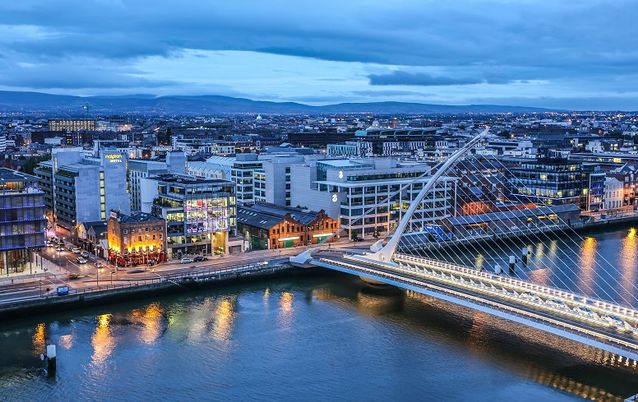
Some of Dublin’s bridges are named after literary figures — the cable-stayed Samuel Beckett Bridge joins Sir John Rogerson’s Quay on the south side of the River Liffey to Guild Street and North Wall Quay in the Docklands area. Pictures: PATRICIA MCCRACKEN
-
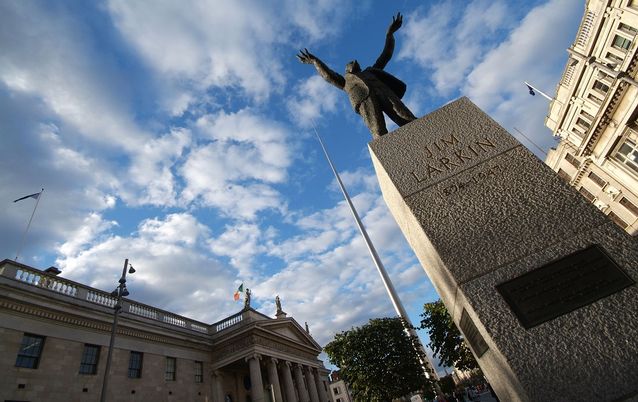
The Jim Larkin statue on Dublin’s O’Connell Street is dedicated to the memory of the founder of the Workers Union of Ireland. Picture: SUPPLIED
THERE’s a place or a view that captures the heart in any favourite city. In Durban for me, it’s that moment when you crest the Tollgate hill and the potential of the city and the bay is laid open before you. Across the world in Dublin, it’s crossing the River Liffey and seeing the layers of past and present rising up beside the quays.
For others who can’t resist picturesque bridges, Dublin offers a couple of dozen along its three rivers and two historic canals, the Grand and the Royal. Probably the most iconic bridge, and frequently used as a visual code for Dublin in film, postcards and Instagram, is the Liffey Bridge, celebrating its bicentenary this year. About 30,000 people a day now walk across this wrought-iron footbridge, generally known as the Ha’penny Bridge after the toll levied there until 1919.
Fellow pontophiles will rejoice that nearly half these bridges have been built in Dublin in the past 40 years. Some of the newer ones are named after literary figures — James Joyce, Sean O’Casey and Samuel Beckett. Female labour activist Rosie Hackett was honoured by a new bridge in 2014.
...
FOR A few years in the 1930s, there was even a phase of naming and renaming Dublin bridges after temperance campaigners. But temperance will be completely out come Thursday, March 17. The city will then be again the epicentre of St Patrick’s Day celebrations, a magnet round the world to the Irish, friends of the Irish and those who’d like to be Irish. What makes this year different, though, is that St Patrick’s Day is just a bridge in a year-long commemoration.
Dubliners are renowned for their love of talking and one subject they’re talking about with renewed fervour is revolution — particularly the 1916 Easter Rising. The main commemorations this month coincide with Easter, but Irish tricolour flags of green, orange and white will be flying high throughout the year.
These celebrations will focus on a post office, which might seem incongruous, to South Africans especially. But Dublin’s General Post Office (GPO) became the headquarters of the Rising after about 1,000 men stormed it on the public holiday of Easter Monday 1916, signalling violent revolution against centuries of British rule. Outside today, you can still see bullet scars pocking the gracefully fluted columns.
This being the 21st century, there’s a free tourism app to guide you around major sites of 1916 and other aspects of Dublin’s history. Despite all those useful bridges, the heart of Dublin is made for walking and even long-time Dubliners say it’s now a nightmare to drive in.
So, wander along street after street of graceful Georgian doorways and through glorious inner-city public gardens (often bequests of the Guinness family). Even upmarket Grafton Street, home to top department store Brown Thomas, has joined Dublin’s pedestrianisation revolution.
...
BE SIDETRACKED into one of the many pubs or chic cafés along the way, the bookshops, and craft galleries. And be ambushed by a surprising bridge back into South African history as well.
Say you’d been inside the GPO in 1916 with the insurgents, you might have had a South African War Mauser in your hands. Several were recovered when British troops crushed the Rising and you can see them now at the National Museum’s Collins Barracks branch, once a British army barracks renamed after revolutionary leader Michael Collins.
Look closely and see how the Mausers’ stocks were carved with pride by Irish lads a couple of decades before the Easter Rising, having been inspired by Boer boldness to join the South Africans in the fight against British imperialism on the veld. History can shift unexpectedly and nearly seven decades after the Rising, thanks mainly to the late Kader Asmal and the Irish Anti-Apartheid Movement, Ireland would lead Europe in imposing sanctions on apartheid SA.
In Dublin, the currents of history twist and turn like the intricate interweaving of a Celtic knot design. Strolling to a lively evening in the Temple Bar area, you’ll pass streets once jammed by Irish anti-apartheid marches. Three or four generations earlier, they were packed by pro-Boer marchers. Leading them was the great beauty Maud Gonne, muse of the poet WB Yeats. At her side was Arthur Griffith, who had spent a couple of years in the then Transvaal, editing (and destroying) the Middelburg Courant, then working on a gold mine and organising Irish nationalist marches in Johannesburg.
...
ON COMING out of Trinity College after admiring the beautiful medieval Book of Kells, you might find yourself round the corner from where Griffith defended Gonne’s honour against a fellow editor, using a sjambok he’d brought back. By then, Griffith was editing the often-banned United Irishman. He would go on to found a newspaper and an organisation called Sinn Féin, Gaelic for "ourselves alone" and based, he said, on Boer principles of self-sufficiency, and was first president of the Irish Free State.
But when revolution started, Griffith was (conveniently, some say) on a cycling holiday in the Wicklow Hills. Even today, about an hour’s drive from central Dublin, you can be on the moorland peaks among the yellow gorse and bog cotton and listening to the plaintive curlew call. If you don’t want to hire a car, there are plenty of day tours to join.
Griffith, a writer and organiser but no fighter, really did not want to be "where the bayonets flash and the rifles crash" as the lines go from Off to Dublin in the Green, which you may well hear spilling out of a "singing pub". But one of Griffith’s colleagues in SA, Mayo-born John MacBride, joined the fight in another importanty, if unlikely sounding, location — Jacob’s Biscuit Factory.
In the South African War, MacBride had led one of the two Irish brigades in the Boer army. At his court martial after the Rising, he retorted: "I have looked down the muzzles of too many guns in the South African War to fear death." Another of the 15 insurgents executed in May 1916 was James Connolly, part of the Irish Pro-Boer Committee with Griffith and Gonne. Infamously, Connolly was shot tied to a chair because he was too ill from wounds to stand.
The nationalism reignited by Dublin’s pro-Boer campaigns had fed Ireland’s slow-burn revolution. The Rising then made martyrs out of men such as MacBride and Connolly. This brought more forward to carry their legacy through the 1920s during the Anglo-Irish war and the civil war.
Visiting Dublin, you’ll find many centenaries of battles and martyrs to muse over. And, always bridging the hemispheres, the unlikely South African connection to ponder.



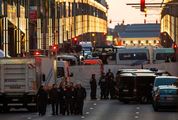
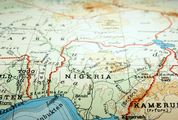



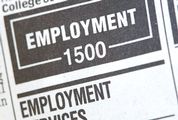












Change: -1.54%
Change: -1.49%
Change: -2.02%
Change: -0.73%
Change: -4.01%
Data supplied by Profile Data
Change: -0.18%
Change: -0.26%
Change: -1.54%
Change: 0.00%
Change: -0.34%
Data supplied by Profile Data
Change: 0.86%
Change: 0.30%
Change: 0.68%
Change: 0.82%
Change: 0.12%
Data supplied by Profile Data
Change: -2.24%
Change: -3.72%
Change: -3.78%
Change: -3.81%
Change: -1.76%
Data supplied by Profile Data